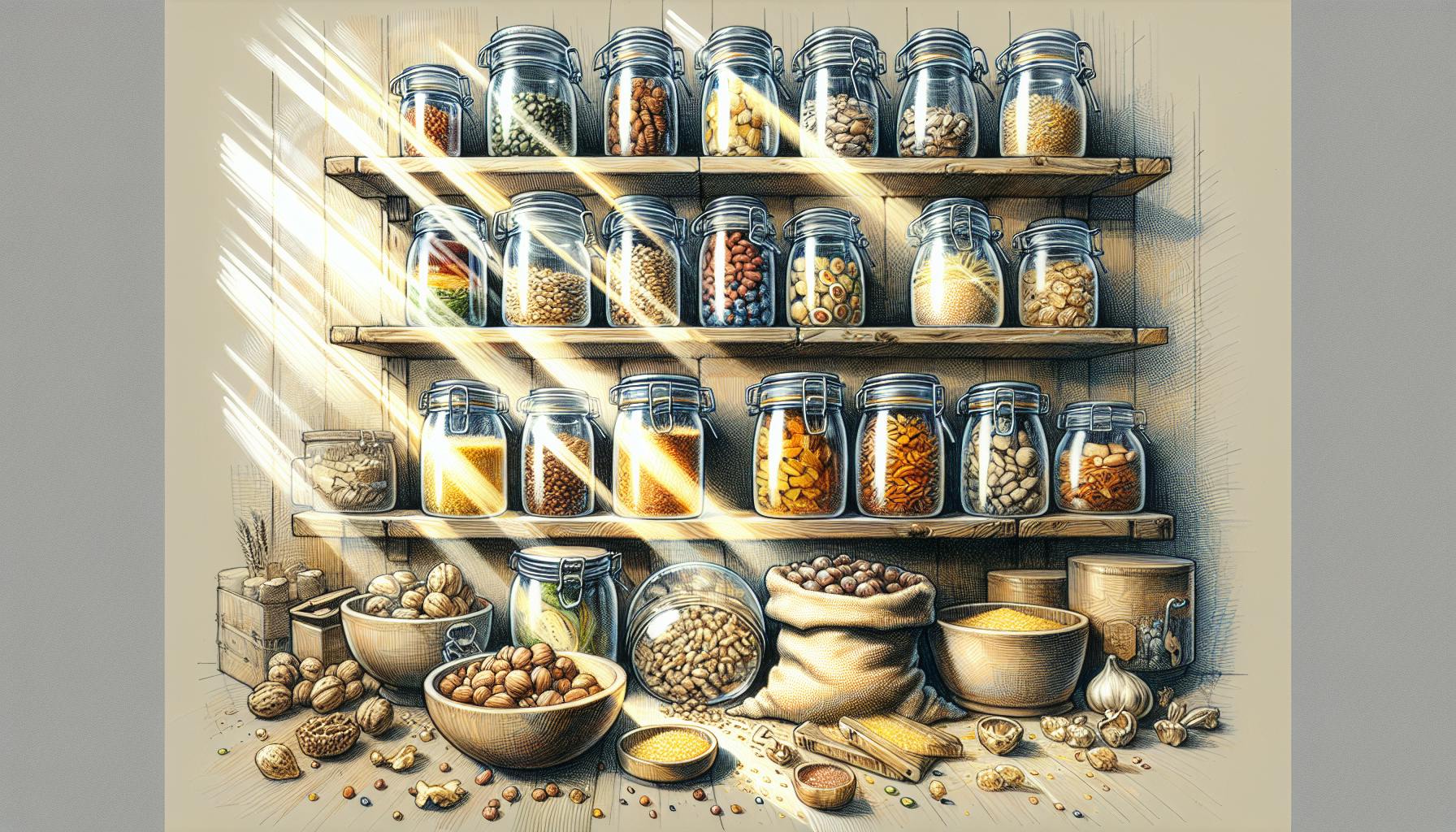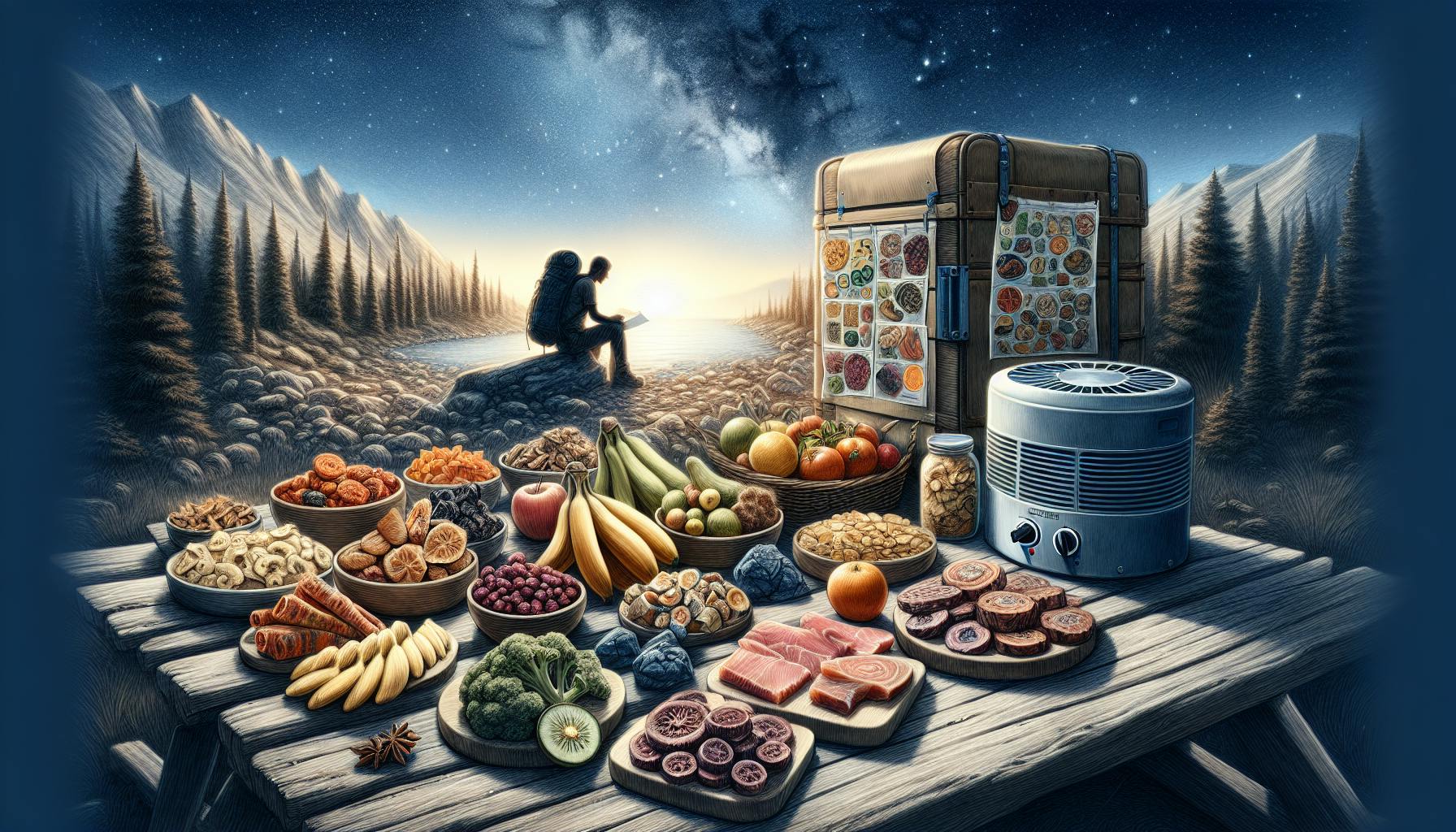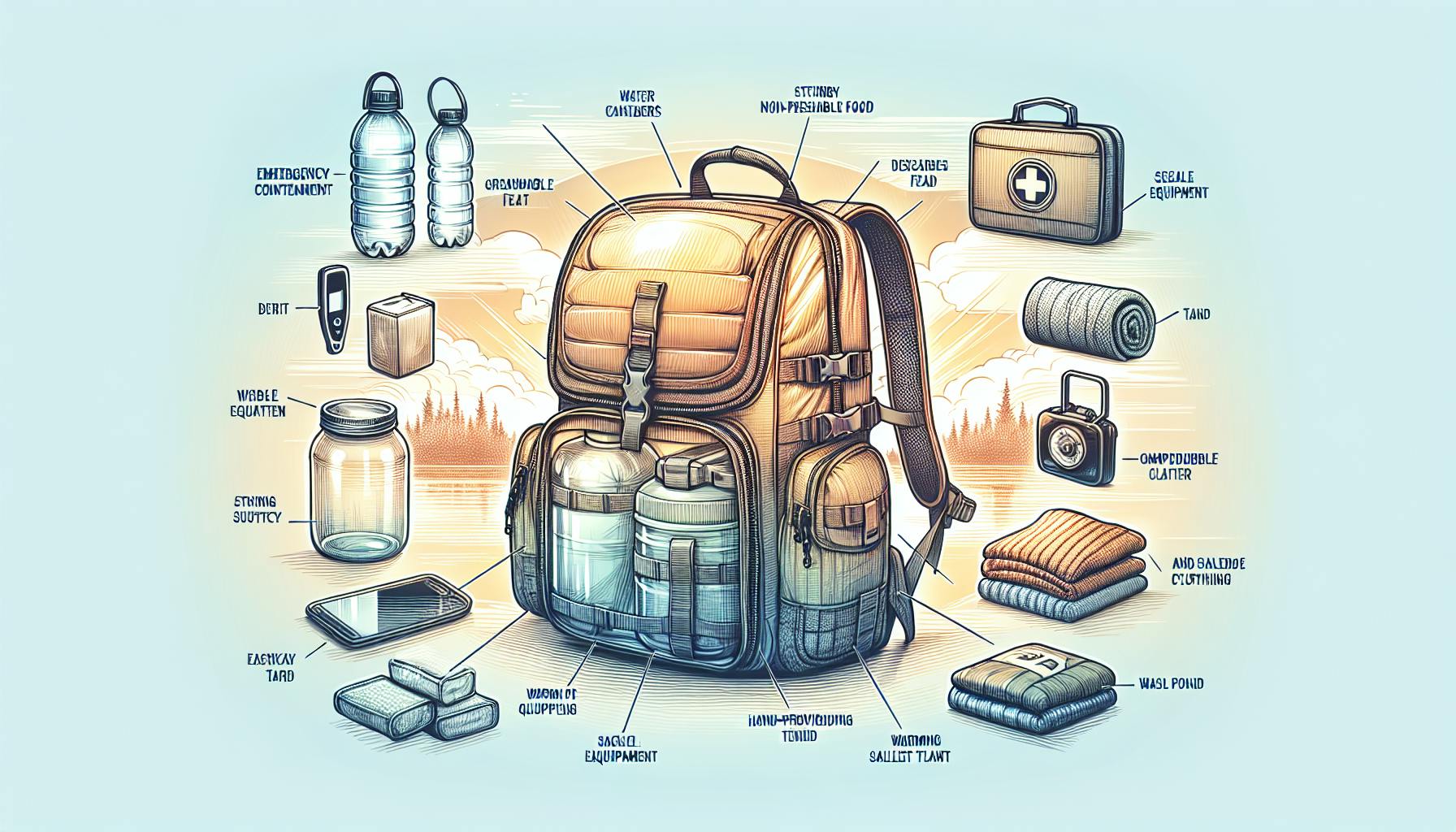When considering doomsday scenarios, most would agree that having the right supplies on hand is critical for survival.
This comprehensive checklist covers all the essential doomsday prepping supplies you need to stockpile, ensuring you don't overlook anything critical when disaster strikes.
You'll get a full run down on must-have items like food, water, first aid, power alternatives, equipment, and more, helping you create a complete survival stockpile for you and your family.
Introduction to Doomsday Prepping Supplies
Preparing for potential doomsday scenarios such as natural disasters, climate change events, or societal collapse is critical for survival. Having the right supplies and being prepared can mean the difference between life and death. This checklist covers the essential items every prepper should have in their doomsday kit.
Understanding Doomsday Scenarios
There are a variety of catastrophic events that preppers take into account when building their doomsday kits:
- Natural disasters - Hurricanes, earthquakes, floods, and tornadoes can destroy infrastructure and cut off access to food, water, and medical care for extended periods.
- Climate change - Rising sea levels, droughts, and extreme weather events may force people from their homes and threaten key resources.
- Societal collapse - Pandemics, wars, or financial crises could fundamentally alter day-to-day life. Being prepared provides stability.
Having emergency supplies helps ensure you can safely meet basic survival needs during these doomsday scenarios.
The Essentials for Survival
When building a doomsday kit, focus first on securing the essentials for survival:
- Food - Stockpile non-perishable foods with a long shelf-life as well as seeds to grow food.
- Water - Store a minimum of one gallon per person per day. Consider water filtration methods.
- Shelter - Have an emergency shelter planned and equip it with basic provisions for living.
Prepping your doomsday kit with adequate food, water, and shelter establishes a foundation for surviving catastrophic events. Prioritize these before moving onto other supplies.
What do I need for doomsday prepping?
Preparing for a doomsday scenario requires gathering critical supplies to ensure survival during a disaster or societal collapse. Having these essential items on hand will provide sustenance, safety, medical care, communication, and other necessities when normal infrastructure fails.
Water
Stockpiling water is the most vital component of a doomsday prepper's supplies. Experts recommend storing at least one gallon of water per person per day for drinking and sanitation needs. Consider storing several weeks' to months' worth of water if possible. Store water in food-grade plastic containers and replace it every six months. Staying hydrated is crucial for health and survival.
Long-Shelf-Life Food
Build up a stockpile of nutritious, non-perishable foods with a long shelf life. Canned goods, freeze-dried meals, protein bars, and MREs (Meals Ready to Eat) are excellent choices. Aim for at least a several week supply of calories and nutrients to feed yourself and family. Rotate and replace food items before they expire.
Communication and Information Devices
Reliable communication and information will be limited when the grid goes down. An emergency hand crank or battery-powered radio will allow you to receive broadcasts and critical emergency updates. A NOAA weather radio with tone alerts provides warnings for impending severe weather. Flashlights, glow sticks, and headlamps serve as light sources when the power fails.
Medical Preparedness
Disasters and societal instability limit access to healthcare, making first aid profoundly important. Stockpile first aid supplies like bandages, gauze, medicines, sanitation items, latex gloves, trauma kits, burn cream, splints, and sutures. Consider taking first aid, CPR, and trauma medical classes now if possible.
Special Considerations
Those relying on prescription medications should stockpile extra supplies. Have contingency plans to safely store insulin, heart medications, and asthma inhalers. Prepare for securing your home, gathering hard currency, and defending yourself if deemed necessary. Continually re-evaluate and update your doomsday prepping supplies as your situation changes.
What items do you need to stockpile before a collapse?
When preparing for a potential societal collapse or doomsday scenario, having the right supplies stockpiled can mean the difference between survival and hardship. Here are some of the most critical items experts recommend keeping on hand:
Food and Water
- Canned goods and non-perishables - Choose items with a long shelf life that don't require refrigeration. Prioritize calories and nutrition.
- Water bottles and filtration systems - Stockpile at least a gallon per person per day for drinking and sanitation needs.
- Cash on hand - Have some physical currency available in case digital payments systems fail.
Tools and Gear
- Flashlights and lanterns with extra batteries
- Manual can opener
- Battery-powered or hand-crank radio
- First aid kit - Include any necessary medications
- Multi-tool or pocket knife
- Emergency blankets and warm clothing
Documentation
- Copies of important documents - ID cards, birth certificates, deeds, licenses, etc.
- Maps of the local area
By keeping these basic doomsday prepping supplies on hand, you'll be better prepared if an extended grid-down scenario or societal disruption ever occurs. Be sure to rotate and replenish anything that has an expiration date.
What do preppers stock up on?
Preppers stock up on a variety of essential supplies to ensure they are fully prepared for any emergency situation. Some of the key categories of supplies that preppers prioritize include:
Dry Bulk Food Staples
There is a lot of nutritious, non-perishable food for preppers to consider stocking up on. High on any prepper's list should be dry bulk food staples such as:
- Legumes like beans, lentils, and peas
- Rice and grains like oats, quinoa, wheat, and barley
- Pasta
- Dried fruits and vegetables
- Dried meats like beef jerky
- Herbs and spices
These types of foods have long shelf lives, are calorie-dense, and provide essential nutrients. Having a deep pantry stacked with these staples will ensure food security when SHTF. Many preppers recommend having at least a 3-6 month supply of these goods.
Water and Water Purification Supplies
In any grid-down or disaster scenario, clean drinking water will be critical to survival. Preppers stockpile bottled water as well as water filtration devices like Lifestraws and water purification tablets. Storing water collection supplies like rain barrels is also important. The general rule is to have at least 1 gallon of water per person per day for drinking and sanitation needs.
First Aid Supplies
Being able to provide self-care during an emergency is vital. Preppers stock their bug out bags and shelters with robust first aid kids containing bandages, gauze, medicines, splints, sutures, and other medical equipment. Having the know-how to use these supplies is also key.
Tools and Hardware
Ropes, duct tape, batteries, flashlights, shovels, axes, wrenches, radios, wire, and other tools are invaluable for survival scenarios. Preppers stockpile versatile items that can serve many purposes and help them construct shelters, hunt, start fires, and complete other necessary tasks if the grid goes down.
Personal Hygiene Items
While often overlooked, hygiene is critical for health and sanitation, especially in confined spaces. Preppers stockpile soaps, toothpaste, toilet paper, feminine products, and related personal care items.
By stocking up on supplies across these essential categories, preppers aim to be fully self-reliant and prepared for any contingency where traditional supply chains and infrastructure are compromised.
How do I start doomsday prep?
Getting started with doomsday prepping can seem overwhelming, but following a structured plan makes the process more manageable. Here are some key steps for beginner preppers:
Take Inventory of What You Already Have
Before buying anything new, take stock of what emergency supplies you already have on hand. This includes non-perishable food, bottled water, first aid kits, flashlights, and other gear. Identify any gaps you need to fill.
Build a 72-Hour Emergency Kit
Start by preparing enough emergency supplies to survive for 72 hours. This includes having 1 gallon of water per person per day, non-perishable food, first aid items, flashlights and batteries. Store your kit in an easily accessible spot.
Expand Your Storage to 2 Weeks
Once your 72-hour kit is complete, work towards having enough supplies for 2 weeks of self-reliance at home during a major disaster. Prioritize shelf-stable food, water, medical supplies, sanitation needs, and communication devices.
Create Evacuation "Bug Out" Bags
In addition to home emergency kits, pack a bug out bag for each family member containing 3 days worth of supplies. This go-bag should have food, water, clothes, medicine, tools, emergency blankets and other essentials in case you must evacuate quickly.
By methodically building your preparedness starting with short-term survival needs and expanding from there, doomsday prepping becomes much more achievable. Develop robust systems for water, food, medical care, communication and security to withstand a long-term crisis.
sbb-itb-b932644
Doomsday Prep Kit Essentials
A comprehensive doomsday prep kit is essential for survival during a major disaster or societal collapse. Key components to stockpile include:
Water Supplies: The Lifeline
Having an emergency supply of water is critical, as most people can only survive 3 days without it. Recommendations for water storage include:
- Store at least 1 gallon of water per person per day for drinking and sanitation needs. Consider storing a 2-week supply to be safe.
- Use food-grade plastic containers with tight lids to store water. Glass bottles can also work.
- Add water purification tablets to kill bacteria and pathogens. Replace stored water every 6 months.
Storing enough water eliminates the need to leave your secure location seeking unsafe water sources.
Emergency Food Supply Strategies
Stockpiling a diverse range of long-shelf life foods is vital to maintain health and energy during a disaster scenario. Useful tips include:
- Focus on nutritious, non-perishable foods like rice, beans, canned meat/fish, honey, oats, trail mixes.
- Calculate necessary calories per person based on age, health needs.
- Continually cycle out and replace food items before expiration dates.
- Store food in airtight, waterproof containers in cool, dark spaces to maximize shelf life.
Having at least a 3-month supply of food eliminates worries about starvation while sheltering during a crisis.
Shelter in Place: Securing Your Refuge
Preparing your home or bug-out location for long-term occupancy is key. Recommendations include:
- Identify and seal off all possible entry points for contaminants.
- Install HEPA air filters and ventilation systems.
- Stockpile medications, first aid supplies, tools and spare parts.
- Know how to quickly shut off water, gas and electricity lines.
Taking these precautions allows your shelter to be self-sustaining and protected.
Survival Gear and Equipment
Reliable survival gear for security, communication, lighting and other needs is a must, including:
- Two-way radios, crank/solar chargers, batteries
- LED flashlights, candles, matches, multi-tool
- Weather appropriate clothing and footwear
- Local maps, camping supplies, weapons
This equipment enhances safety and sustains critical functionality when infrastructure fails.
By thoroughly preparing with ample stocks of water, food, medical supplies and survival equipment, your doomsday shelter and provisions will be equipped to keep you securely sustained.
Comprehensive Prepper Supplies Checklist
Being prepared for emergencies requires having the right supplies on hand. This checklist covers many of the most important items to stockpile.
25 Items Every Prepper Should Stockpile
These are some of the most essential things to have in your prepper stockpile:
- Water and water purification supplies
- Non-perishable food and emergency rations
- First aid kits and medical supplies
- Flashlights, batteries, and alternative light sources
- Multi-tool, knife, duct tape, and other tools
- Emergency radios, chargers, and backup power options
- Extra fuel, propane, etc.
- Personal hygiene and sanitation items
- Warm clothes, blankets, gloves, and cold weather gear
- Basic weapon for security and hunting
- Paper maps and navigation tools like compass
- Prescription medications
- Cash in small bills and coins
- Important documents in waterproof container
- Shelter supplies like tent, tarp, rope
- Fishing tackle and traps
- Vegetable seeds and gardening tools
- Canned goods and non-electric can opener
- Baby/pet supplies if needed
- Board games, cards for entertainment
First Aid and Prescription Medications
Having medical and first aid supplies is vital, including:
- First aid kits and manuals
- Pain medications
- Bandages and wound care items
- Medications and prescriptions
- Supplements like vitamins
- Burn cream and treatments
- Snake bite and insect sting kits
- Splints and braces
Stockpile at least a 90 day supply of prescription medications if possible.
Power and Energy Alternatives
It's critical to have backup power sources:
- Solar panels and chargers
- Generators and fuel
- Emergency candles and light sources
- Batteries of all sizes
- Hand crank chargers and radios
Also know how to safely turn off utilities like gas, electric, and water in your home. Understanding power grid operations like "black start" can help in prolonged outages.
Communication Devices and Backup Plans
Have communication equipment like:
- Emergency radios
- Two-way radios
- Satellite phones if possible
- Signal flares
Also have backup plans to communicate like:
- Meeting spots
- Contacts outside area
- Established emergency signal system
The ability to receive emergency broadcasts and contact aid is key when normal communication channels fail.
Doomsday Survival Kit List for Evacuation
Grab-and-Go Bags
Having pre-packed grab-and-go bags ready in case of emergency evacuation can be a lifesaver. These should contain basic survival items tailored to your personal needs, including:
- Bottled water and non-perishable food like protein bars
- Flashlight, battery bank/charger, radio
- Basic first aid kit and essential medications
- Extra cash, copies of ID/passport
- Weather-appropriate clothing and shoes
Store your grab-and-go bags in accessible locations around your home, office, or vehicle. Check contents every 6 months and replenish as needed.
Navigation and Travel Supplies
When evacuating unfamiliar areas, having navigation tools on hand is critical in case you lose phone/GPS signal. Useful items include:
- Detailed road maps and topography/terrain maps
- Compass and protractor for orienteering
- Pen/paper for writing directions or leaving notes
- Signal mirror, whistle, flare for signaling location
Knowing alternate evacuation routes beforehand through careful planning can also prove invaluable if main roads are blocked.
Essential Documents and Cash Reserves
Vital records should be kept in a waterproof container inside your go-bag for quick access during evacuation:
- Identification documents
- Insurance information
- Bank/credit card statements
- Backup digital copies on a thumb drive
Having small denominations of cash on hand is also wise in case ATMs and payment systems are down.
Clothing and Personal Protection
Pack clothing suitable for different environments, including:
- Insulated and waterproof jackets
- Sturdy, protective boots or shoes
- Work gloves to handle debris or barbed wire
- Dust masks, goggles for eye protection
- Helmets for falling object protection
Also consider adding personal safety items like pepper spray, pocket knives, or walkie-talkies depending on your situation.
Prioritizing mobility, versatility and durability makes your doomsday evacuation kit more effective when rapid response is essential.
Maintaining Your Doomsday Prepping Supplies
Regular Inventory and Rotation
It is important to take regular inventory of your doomsday prepping supplies and rotate items to ensure freshness and usability. Set reminders to go through your stockpile at least every 3-6 months. Check expiration dates, look for signs of spoilage or damage, and replace anything that may be expired or unusable. When restocking, put newer items behind older ones so the older supplies get used first. This first in, first out rotation system helps avoid waste.
Safe Storage Solutions
Properly storing your doomsday prepping supplies is key to preserving their integrity. Consider climate conditions and store items appropriately. For example, extremes of heat or cold can damage food, medications, and gear. Store supplies in sealed plastic bins or storage containers to protect from pests. You may want to keep certain emergency items easily accessible, while hiding and securing the bulk of your stockpile. Develop an organized system that fits your space and needs.
Skill Development and Training
Simply having doomsday prepping supplies is not enough - you need to know how to use them. Take time to develop key survival skills like first aid, navigation, shelter building, hunting/foraging, and more. Train regularly with any tools or gear you have acquired as part of your stockpile. Attend survival training courses if possible. Hands-on practice will ensure you can truly rely on your preps when needed most.
Community and Network Building
Connect with like-minded individuals who share an interest in emergency preparedness. Share ideas, resources, and skills to make each other more resilient. In a doomsday scenario, having a network of people you can count on and collaborate with will be invaluable. Build relationships now so bonds are already formed if disaster strikes. Just be cautious about openly discussing the details of your personal preps for security reasons.
Conclusion: Final Prepper Supplies List Review
Checklist Recap and Prioritization
Having the right supplies is critical for doomsday prepping. Here is a recap of some of the most essential items:
- Water - Stock up on bottled water and water filtration systems. Aim for at least one gallon per person per day.
- Long-lasting food - Canned goods, freeze-dried meals, protein bars. Focus on calorie-dense foods with long shelf lives.
- First aid - Bandages, medicines, sanitation supplies. Know how to treat injuries when medical care is limited.
- Tools and supplies - Flashlights, batteries, multi-tools, duct tape. Useful for repairs, building shelters, hunting/fishing, etc.
Prioritize the basics like water and food first. Then layer on tools, medical supplies, and other gear based on likely risks in your region and personal needs.
Adapting to Changing Conditions
Regularly review and update your supplies checklist. Account for evolving threats like climate change, cyber attacks, civil unrest. The future is uncertain so be ready to pivot.
Consider weather-related risks in your area and how they may shift. Prepare for both warming and cooling trends. Expand renewable energy capabilities.
Resources for Continued Learning
- Prepper Supplies Checklist PDF from the CDC
- Ready.gov planning guides for different threats
- Online prepper communities to exchange ideas
Keep learning, evaluating risks, and refining your preparations. Being a preparedness-minded community is key.


